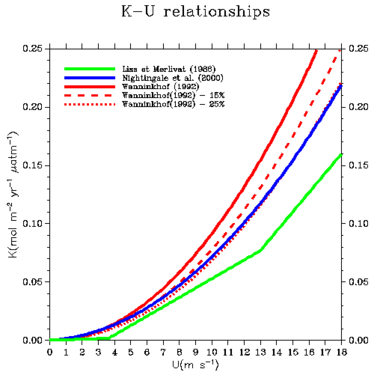Relating air-sea gas transfer velocities, k, to wind speed, U
Several attempts have been made to relate air-sea gas transfer velocities, k, to wind speed, U. Relating k to U is not completely satisfactory because k is known to be driven by sea surface roughness which is not only dependent on wind speed and alternative approaches attempt to relate k to sea surface slopes (Frew et al., 2004) that is accessible using dual-frequency altimeters. However, scatterometer instruments provide a much better spatial coverage than altimeters.
At present, three k-U relationships are commonly used to derive CO2 air-sea fluxes from wind speed and air-sea CO2 partial pressure gradient:
- The Liss and Merlivat (1986) relationship deduced from process studies in wind tunnel and calibrated with lake measurements.
- TheWanninkhof (1992) relationship deduced by assuming (1) k is proportionnal to U2, (2) the global distribution of U is a Rayleigh distribution and (3) the global k average is constrained by the Broecker et al. (1985) ocean 14C inventory (Kbroecker).
- The Nightingale et al. (2000) relationship deduced from in situ tracer measurements (SF6,3He) performed at sea and assuming a second order polynomial k-U relationship.
As expected from older studies, global mean K values deduced from these 3 k-U relationships are quite stable temporally (no seasonal cycle) but the K deduced from various relationships disagree by up to a factor 1.8 and this factor varies regionally (Boutin et al., 2002).
Liss and Merlivat
The Liss and Merlivat [1986] parameterisation was deduced, taking into account the physics of the air-sea interface, from wind tunnel measurements. Lake measurements were used for normalisation. It is divided in three regimes, smooth surface, rough surface and breaking waves regimes:
0<=U<=3.6m/s k[LM]=(0.17*U10)* (600./Sc)**0.66 3.6<U10<=13m/s k[LM]=((2.85*U10) - 9.65)*(600./Sc)**0
Nightingale
The Nightingale et al. [2000] parameterisation was deduced from dual tracers experiments at sea:
k[N]=(0.222U10**2 + 0.333U10) * (600/Sc)**0.5
Wanninkhof
The Wanninkhof [1992] parameterisation used a quadratic fit to the bomb 14C inventory. Since we use high resolution satellite wind speeds, we choose the parametrisation suitable for short term wind speed:
kW=(0.31 U10**2)* (660/Sc)**0.5











